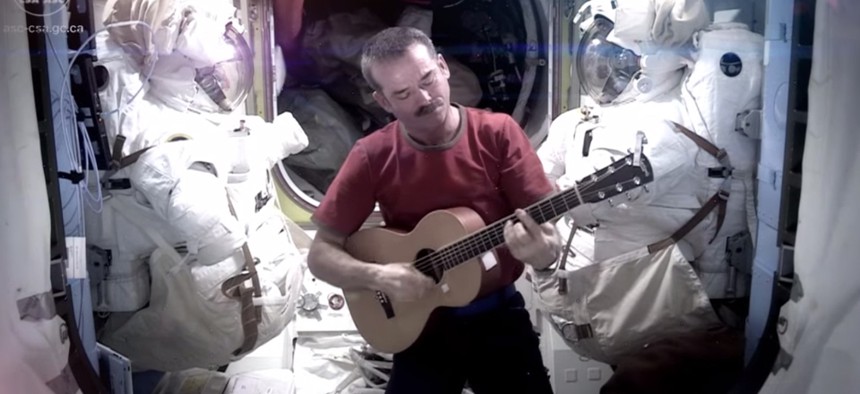How to Go Viral From Space

Canadian Space Agency via YouTube
Orbital YouTubing made Chris Hadfield an Internet sensation—and got millions of people hooked on science.
Chris Hadfield knows all about spacewalking, piloting a fighter jet, and living on the ocean floor. The mustachioed Canadian might also be the Internet's most unlikely music-video superstar.
But of course, when you can film your performance in zero gravity, why wouldn't you expect to get 22 million hits?
But Hadfield's world-famous rendition of "Space Oddity" isn't his proudest achievement. For him, it's the fact that millions of people who have watched his YouTube videos have become interested in science and space. Most gratifying, he says, is "seeing people change their mind and do something more challenging and productive with their life as a result of seeing me as an example."
Over a 21-year spaceflight career, Hadfield, 54, became the first Canadian to spacewalk, as well as the first to use the robotic Canadarm. He also spent time on an undersea mission helping NASA simulate space expeditions.
During that time, he's had plenty of opportunities to help others learn about life in orbit, whether speaking to school groups or filming educational videos. "I used the best technology that was available each time to try and share the experience with everybody," he said.
On his final mission, from late 2012 to early 2013, he used the power of YouTube to reach the masses as never before. In five months aboard the space station, Hadfield filmed nearly 100 videos, demonstrating everything from shaving to exercising to sleeping to crying in space.
Hundreds of thousands of people (sometimes millions) saw each video, and Hadfield said the response has been overwhelming. "Constantly, every single day, I get emails," he said. "People stop me on the street."
Among the many who have felt the impact of Hadfield's career is current Canadian astronaut Jeremy Hansen, who first met his predecessor when he was still a student. "He made those decisions [to become an astronaut] because he was inspired by the space program and the work I was doing," Hadfield said.
It's a journey inspired in much the same way as Hadfield's own. Hadfield credits Neil Armstrong and Buzz Aldrin for inspiring his own career. "I chose to do what I've done with my life because of those initial NASA astronauts," he said. "They were the first reality TV. It was the ultimate reality TV." And while his YouTube videos might come in a different format than their live moonwalk, Hadfield sees a common thread: "clear communication of a new experience."
For Hadfield, that communication helped people get a glimpse of "everyday" life in space—far from everyday for folks on the ground. Even simple tasks, he said, can get tricky in weightlessness. "It's almost always the opposite," he said. "Something that's easy on Earth is hard in space, and vice versa."
Perhaps most difficult? Putting on a pair of shoes. Without the benefit of gravity, Hadfield found it tricky to maneuver his feet and pull on a shoe. "By the time you get one shoe on, the other's disappeared," he said.
Of course, even more difficult was the time spent away from his wife and three children. But floating above the Earth isn't the loneliest part of being an astronaut. The years of training for each mission, during which Hadfield was away from home two-thirds of the time, made for more irregular communication than his time in space. "Being in space was pretty reliable," he joked. "People knew where I was."
Hadfield, who grew up in southern Ontario, returned to Canada after retiring in 2013. But he's still keeping a close eye on orbital developments. Much has been made of the tension between the U.S. and Russia (especially NASA's partial cut-off of communication with Moscow), but Hadfield doesn't think the International Space Station partnership is in any danger.
"I think more than ever you need an example like the space station," he said. "Any kid in the Ukraine or any kid in Russia or any kid in the U.S. can walk out in the morning or at dusk and see the station in the sky. It is a visible example of how we can accomplish stuff when we find ways to work together."
He says he's proud of his own work in setting that example. "Throughout my astronaut career, that was one of my objectives. How do I share this experience?" he said. "Between the science videos, education videos, and the music videos, there have been millions of people who understand the space station differently."





